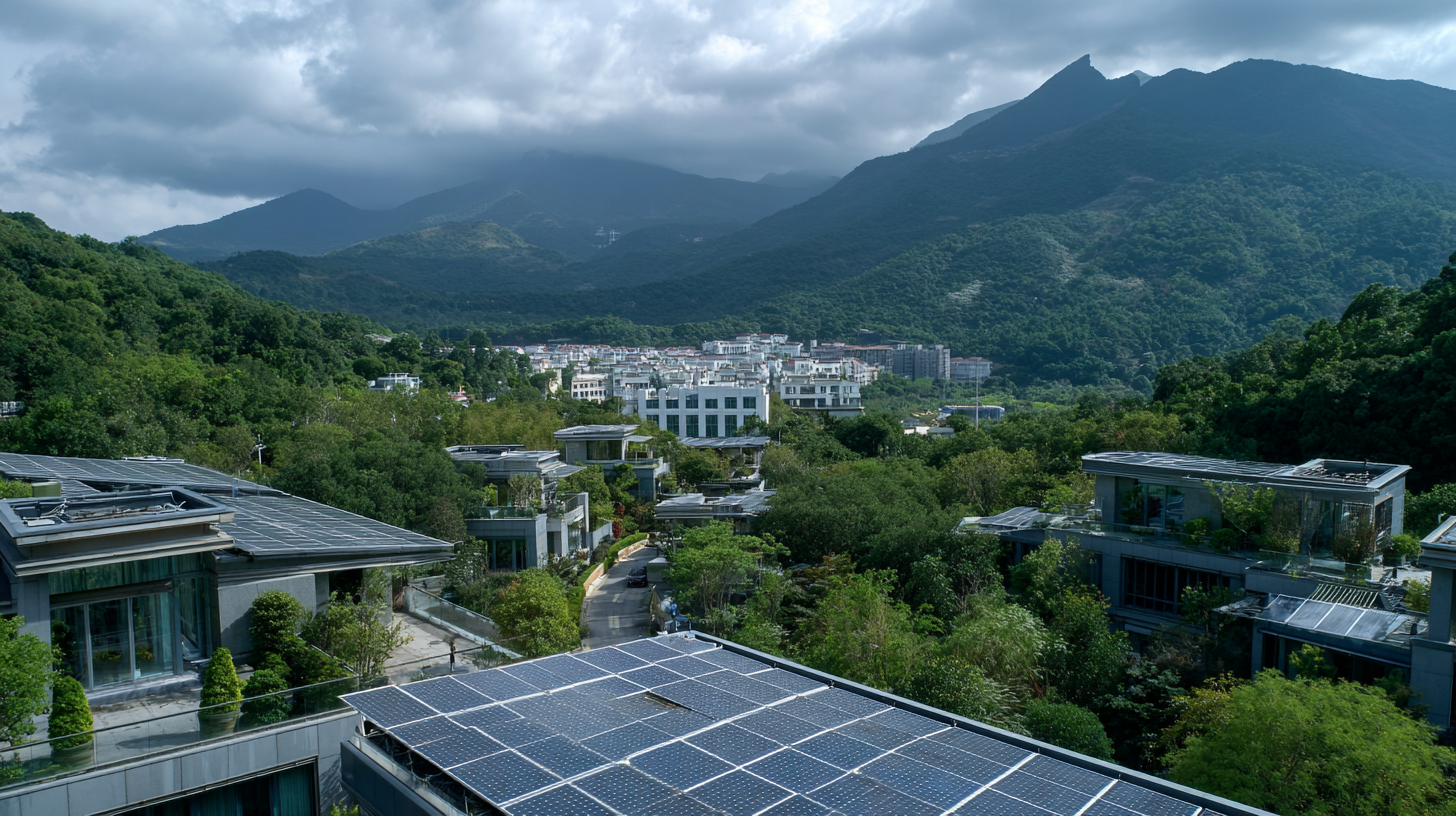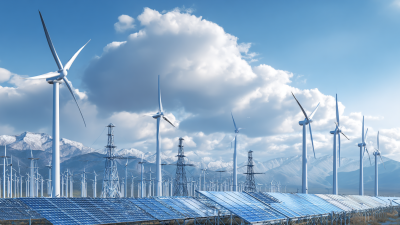The Future of Sustainable Living Exploring the Innovations in Re Energy Solutions
In an era where climate change poses a significant threat to our planet, the transition to sustainable living has become more crucial than ever. The re energy sector is at the forefront of this revolution, driving innovations that not only promise to mitigate environmental impact but also enhance our quality of life. As Dr. Emily Roth, a leading expert in renewable energy technologies, aptly stated, "The future of energy lies in our ability to harness natural resources in a way that not only meets demand but also protects our environment for generations to come."

The evolution of re energy solutions is opening new pathways toward sustainability, offering alternatives that range from solar and wind power to advanced energy storage systems. These innovations are not just technologies; they represent a shift in mindset, encouraging communities and individuals to reconsider their relationship with energy consumption and the overall ecosystem. As we explore the exciting developments within the re energy landscape, it is essential to understand how these innovations can reshape our homes, cities, and lifestyles, paving the way for a more sustainable future.
As we embark on this journey to discover the future of sustainable living, we will delve into the latest advancements and the pivotal role they play in promoting responsible energy use. The convergence of technology and sustainability in the re energy sector is not just a trend; it is a fundamental shift towards a healthier planet, empowering us to leave a lasting legacy for those who will follow.
Emerging Renewable Energy Technologies Reshaping Sustainable Living
The emergence of renewable energy technologies is revolutionizing the way we approach sustainable living. According to the Global Renewable Energy Report 2023, investments in renewable energy reached an unprecedented $500 billion last year, highlighting a significant shift towards greener solutions. Innovations such as solar photovoltaic systems, offshore wind farms, and advanced energy storage solutions are paving the way for a more sustainable energy future. These technologies not only reduce our reliance on fossil fuels but also promote energy independence and resilience in local communities.
Tip: Consider integrating solar panels into your home to harness clean energy and reduce utility costs. Recent studies indicate that residential solar installations can lower energy expenses by up to 50%.
Moreover, the rise of smart grid technology is enhancing energy efficiency by allowing real-time data monitoring and energy distribution management. This development ensures that energy consumption is optimized, aligning with sustainability goals. Reports from the International Energy Agency highlight that smart grids could reduce greenhouse gas emissions by up to 20% by 2040, facilitating a dramatic decrease in our carbon footprint.
Tip: Join local initiatives or community solar programs to maximize the benefits of renewable energy and play an active role in your community’s transition toward sustainability. This engagement can also provide cost savings while boosting local renewable energy projects.
The Role of Solar Energy Innovations in Achieving Net-Zero Goals
 The pursuit of net-zero goals hinges significantly on innovations in solar energy. Recent advancements in photovoltaic technology are making solar panels more efficient and accessible than ever. Innovations such as bifacial solar panels, which capture sunlight from both sides, and solar tracking systems that optimize angle exposure, are helping to maximize energy production. As countries strive to reduce carbon footprints, integrating these technologies into urban planning and infrastructure is crucial for sustainable living.
The pursuit of net-zero goals hinges significantly on innovations in solar energy. Recent advancements in photovoltaic technology are making solar panels more efficient and accessible than ever. Innovations such as bifacial solar panels, which capture sunlight from both sides, and solar tracking systems that optimize angle exposure, are helping to maximize energy production. As countries strive to reduce carbon footprints, integrating these technologies into urban planning and infrastructure is crucial for sustainable living.
Tips for Solar Energy Adoption:
- Educate yourself about local solar incentives and rebates that can substantially reduce installation costs.
- Consider solar panel maintenance; regular cleaning and inspections can enhance efficiency and longevity.
- Explore community solar programs if direct installation isn't feasible; these initiatives allow more people to benefit from solar energy.
Transitioning to renewable energy sources, particularly solar power, is not just a trend; it's a necessity for reaching global sustainability targets. The continued focus on solar energy innovations will undoubtedly play a pivotal role in driving forward our collective journey towards a more sustainable future.
Adoption of Wind Energy: Recent Advances and Market Growth Statistics
The adoption of wind energy has seen remarkable growth in recent years, driven by technological advancements and a rising commitment to sustainable living. Innovations in turbine design and efficiency have significantly enhanced the capacity of wind farms to generate clean energy. These technological leaps not only reduce the cost of electricity generation but also increase the feasibility of wind energy in diverse geographic locations, from coastal regions to mountainous areas. The integration of digital technologies, such as predictive analytics and IoT, further optimizes the operation of wind energy systems, maximizing their output and reliability.
Market growth statistics indicate a robust upward trend in the wind energy sector. According to recent reports, wind energy capacity has doubled globally over the past decade, with countries like the United States, China, and Germany leading the way. This surge is accompanied by supportive government policies and incentives that encourage investments in renewable energy infrastructure. As public awareness of climate change and environmental sustainability grows, the wind energy market is poised for continued expansion. The combination of innovative solutions and market dynamics ensures that wind energy will play a critical role in achieving a sustainable future.
Energy Storage Solutions: Enhancing Renewable Energy Reliability and Efficiency
The transition to renewable energy sources has brought about a pressing need for effective energy storage solutions, essential for enhancing the reliability and efficiency of these alternatives. According to a report by the International Renewable Energy Agency (IRENA), the global energy storage market is expected to grow to over 1,095 GWh by 2030, driven predominantly by advancements in battery technology and increasing demand for renewable energy integration. Innovations such as lithium-ion batteries and flow batteries are playing a pivotal role in this evolution, allowing for greater energy retention and reducing dependence on fossil fuels.
Moreover, the integration of energy storage systems with renewable energy sources, like solar and wind, is crucial for tackling intermittency issues. A 2021 study by the U.S. Department of Energy found that energy storage can provide 80% of the necessary services to balance the grid when paired with renewable energy generation. This not only enhances the overall resilience of energy systems but also contributes significantly to reducing greenhouse gas emissions. As industries and households increasingly adopt these technologies, they pave the way for a more sustainable and reliable energy future.

Smart Grid Technologies: Revolutionizing Energy Distribution and Consumption Patterns
The emergence of smart grid technologies is revolutionizing the way we distribute and consume energy. By integrating digital communication, these technologies enable a two-way exchange of information between consumers and utility providers. This interactive network not only enhances the reliability of energy supply but also optimizes energy consumption patterns. Smart meters, for instance, allow users to monitor their energy usage in real-time, empowering them to make informed decisions about their consumption and reduce wastage.
**Tips:** To maximize the benefits of smart grids, consider investing in a smart meter for your home. It will provide insights into your energy usage habits. Additionally, participate in demand response programs that often reward consumers for reducing their consumption during peak hours.
The overall impact of smart grid technologies extends beyond individual users. They facilitate the incorporation of renewable energy sources into the grid, promoting cleaner alternatives. As more homes and businesses adopt solar panels and wind turbines, smart grids can effectively manage this decentralized energy production, ensuring that surplus energy is utilized rather than wasted.
**Tips:** When considering renewable energy options, check if your utility provider supports net metering, which allows you to sell back excess energy generated from your renewable sources back to the grid.
The Future of Sustainable Living: Exploring Innovations in Energy Solutions
| Energy Solution | Type | Efficiency (%) | Cost ($/kWh) | Carbon Emissions (gCO2/kWh) | Deployment Year |
|---|---|---|---|---|---|
| Solar Photovoltaic | Renewable | 18-22 | 0.06 | 40 | 2010 |
| Wind Turbines | Renewable | 35-45 | 0.04 | 10 | 2015 |
| Battery Storage | Energy Storage | 85 | 0.17 | 20 | 2020 |
| Smart Grids | Technology | - | - | - | 2023 |
| Hydro Power | Renewable | 35 | 0.03 | 5 | 2000 |
Related Posts
-

Harnessing Wind Energy for a Sustainable Future Beyond Fossil Fuels
-

Unlocking the Future: How Alternative Energy Solutions Can Power a Sustainable Tomorrow
-

Harnessing Smart Grid Energy Innovations at the 2025 China Import and Export Fair
-

Exploring Sustainable Energy Innovations at 2025 China 138th Canton Fair
-

Harnessing Wind Power Energy for a Sustainable Future in Innovative Technologies
-

Exploring Alternative Energy Innovations at the 138th Canton Fair 2025: A Data-Driven Insight

